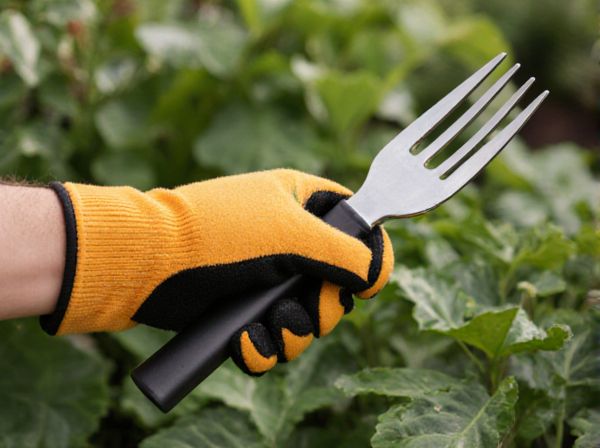
Hand Fork vs Cultivator Illustration
A hand fork features short, sturdy tines ideal for breaking up soil and removing weeds in tight spaces, providing precise control for detailed garden tasks. A cultivator typically has longer, more flexible tines designed to aerate soil and mix in fertilizers over larger areas efficiently. Choosing between a hand fork and a cultivator depends on the scale of your gardening project and the type of soil preparation required.
Table of Comparison
| Feature | Hand Fork | Cultivator |
|---|---|---|
| Purpose | Breaking soil, aerating, weeding | Loosening soil, mixing, weed control |
| Design | Short handle, 3-5 metal tines | Longer handle, multiple curved tines |
| Best Use | Small garden beds, tight spaces | Larger garden areas, rows, bulk soil prep |
| Material | Steel tines, wooden or plastic handle | Steel tines, wooden or metal handle |
| Weight | Lightweight, easy to handle | Heavier, requires more effort |
| Maintenance | Easy to clean, occasional sharpening | Regular cleaning, more frequent sharpening |
| Price Range | Low to moderate cost | Moderate to high cost |
Hand Fork vs Cultivator: Key Differences Explained
Hand forks feature three or four sturdy tines ideal for loosening soil and removing weeds in tight garden spaces, while cultivators have multiple curved tines designed to aerate and mix soil over larger areas efficiently. The hand fork's compact size offers precise control for detailed tasks, contrasting with the cultivator's broader reach suited for preparing garden beds. Selection depends on the scale of gardening work, with hand forks favored for small plots or container gardening and cultivators preferred for extensive soil cultivation.
Understanding the Design of Hand Forks and Cultivators
Hand forks feature short, sturdy tines designed for digging, loosening soil, and aerating small garden beds with precision. Cultivators have multiple flexible tines arranged in rows to efficiently break up soil, remove weeds, and mix compost over larger areas. The design difference influences their use: hand forks excel at targeted soil manipulation, while cultivators cover wider ground for soil preparation.
Primary Uses: When to Choose a Hand Fork
A hand fork is ideal for precise tasks such as loosening soil in tight spaces, aerating compacted ground, and removing weeds near delicate plants. Unlike a cultivator, which is better suited for breaking up larger soil areas and mixing mulch, a hand fork offers greater control for detailed gardening work. Choose a hand fork when working in small garden beds, containers, or around established plants that require careful soil management.
Best Applications for Garden Cultivators
Garden cultivators excel at aerating soil, breaking up compacted earth, and removing weeds between rows of plants, making them ideal for maintaining larger garden beds. Their tines penetrate deeper and cover wider areas compared to hand forks, which are better suited for precision tasks in small spaces or container gardening. Choosing a garden cultivator enhances efficiency and promotes healthier plant growth by improving soil texture and nutrient absorption in medium to large garden plots.
Soil Preparation: Which Tool Performs Better?
Hand forks excel in loosening compact soil and digging small holes, making them ideal for detailed soil preparation in garden beds. Cultivators are more efficient for aerating and mixing soil over larger areas, breaking up clumps and incorporating organic matter quickly. For precise soil preparation, hand forks perform better, while cultivators offer speed and coverage for broader tasks.
Ease of Use: Comfort and Ergonomics Compared
Hand forks typically feature a simple, lightweight design with ergonomic handles that reduce wrist strain and enhance grip comfort during extended use. Cultivators often have wider tines and longer handles, promoting better leverage and less bending, which minimizes back fatigue. Both tools prioritize user comfort, but hand forks excel in precision tasks while cultivators offer ease of use for larger soil loosening jobs.
Maintenance Tips for Hand Forks and Cultivators
Proper maintenance of hand forks and cultivators includes regular cleaning to remove soil and debris, preventing rust by drying tools thoroughly after use, and applying a light coat of oil to metal parts. Sharpening the tines of hand forks and cultivators using a file ensures efficient soil penetration and reduces effort during gardening tasks. Storing tools in a dry, sheltered location protects them from weather damage and extends their lifespan.
Durability and Material Quality: What to Expect
Hand forks are typically crafted from high-carbon steel, offering superior durability and resistance to bending or breaking during heavy-duty gardening tasks. Cultivators often feature stainless steel or reinforced alloy tines designed for flexibility and longevity, though they may wear faster in rocky soil conditions. Expect hand forks to maintain structural integrity longer, while cultivators excel in enduring repeated use with less risk of rust when properly maintained.
Price Comparison: Hand Forks vs Cultivators
Hand forks generally cost between $10 and $30, making them an affordable option for small gardening tasks. Cultivators, depending on their size and power source, range from $20 for manual versions to over $200 for gas or electric models. The price difference reflects the cultivator's enhanced efficiency and versatility compared to the simpler, budget-friendly hand fork.
Choosing the Right Tool for Your Garden Tasks
Selecting the right garden tool depends on the specific task: hand forks excel at loosening compact soil and digging around plants, offering precise control for small to medium areas. Cultivators are designed for aerating soil and removing weeds over larger garden beds, improving soil texture efficiently. Understanding the scale and purpose of your gardening work ensures optimal tool performance and plant health.
Hand Fork vs Cultivator Infographic

 gardendif.com
gardendif.com